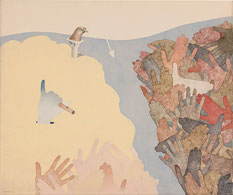

The artist seems to have developed a methodology in which he naturally surrenders his creative antenna to the internal promptings of an unknown source. There is almost an uncanny way of delving into the subterranean steam of his inner being. The forms that appear on the picture surface at first seem unfamiliar through given with a degree of finality that is almost irresistible. These unknown forms begin to grow on the viewer thereby inviting one to look about in the hope of discovering similar images in and around the surroundings. In more recent times, more than these visual forms on the canvas, the artist seems to be perennially interested in feeling out the vast and expansive space around. Often the makes these sculptural forms with just one or two broad strokes of his brush that bespeak of spontaneity and deftness of execution.
In the works of his slightly earlier period, the artist shows a proclivity for filling out the entire space with mostly round and rectilinear colour patches thereby focusing mainly on the total composition. He has an interesting way of building up the picture space by putting the sharply contoured colour patches against a thinly laid surface usually a tint of sap green or ochre. The tonal variations in the same colour patches create an illusion of three-dimensionality. Some of these works are faintly reminiscent of the collages of S. R. Bhushan done during a particular phase by this eminent artist. Tones of grey, green and ochre punctuated by a stray line or stroke of some darker shades of red or blue abound in these paintings. The semiotic elements used in these works seem to have been borrowed mostly from an aerial view of crowded cityscapes.
In the works of his slightly earlier period, the artist shows a proclivity for filling out the entire space with mostly round and rectilinear colour patches thereby focusing mainly on the total composition. He has an interesting way of building up the picture space by putting the sharply contoured colour patches against a thinly laid surface usually a tint of sap green or ochre. The tonal variations in the same colour patches create an illusion of three-dimensionality. Some of these works are faintly reminiscent of the collages of S. R. Bhushan done during a particular phase by this eminent artist. Tones of grey, green and ochre punctuated by a stray line or stroke of some darker shades of red or blue abound in these paintings. The semiotic elements used in these works seem to have been borrowed mostly from an aerial view of crowded cityscapes.

Kurukshetra, 84 x 99 cms, acrylicon canvas, 1996

Birdseller, 45x33 cms, watercolour on paper, 1966




